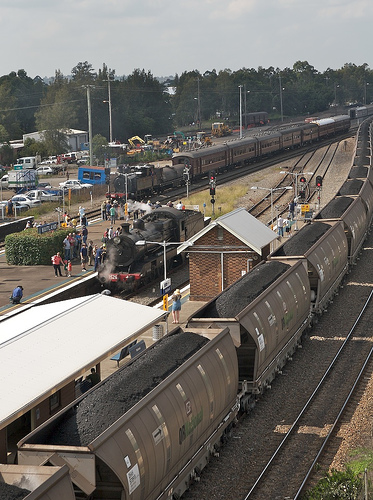Those concerned about coal dust from export terminals in the Northwest might do well to cast an eye Down Under. Australia is currently the world’s leading coal exporter, and therefore provides an instructive lesson in the ways that transporting and handling of large volumes of coal can affect nearby communities.
Several places in Australia have experienced serious problems with coal dust from railways and export terminals. Here’s how the coal transport industry describes the problem:
Across Australia, dust from trains carrying coal and iron ore is a persistent problem. For residents next to a rail track in the Bowen Basin or Hunter Valley it can, on the worst days, mean dust obscuring windows, dirtying washing and penetrating homes…
And in another article, the same trade journal says:
Ever since trains have been used to transport coal, fugitive dust has been a source of complaints from communities near the rail lines.
Remember, that’s not the perspective of greens or community members. That’s the industry talking.
To be fair, though, that second article also alleges that mitigation measures have reduced coal dust problems by 50 to 90 percent along the particularly dust-plagued route from the Callide region coal mines to Gladstone, a major coal export region on Australia’s east coast.
Yet despite the improvements the shippers claim, coal dust is apparently still a serious problem in Gladstone.
The Queensland government admits that coal dust from trains exceeds air quality standards in the Gladstone area. Yet newspaper accounts paint a more startling picture.
Here’s the Gladstone Observer:
BLACK coal dust is back in Gladstone homes as coal supplies return back to normal at the Barney Point Coal Terminal.
For the past month Gladstone residents have been breathing a little easier and doing less cleaning as coal supplies dried up at Barney Point due to floodwaters inundating coal mines across Central Queensland.
No coal supplies for many residents has meant cleaner benches and window sills, however, coal production has ramped up over the past week with the opening of the Blackwater rail line and, as a consequence, so has the coal dust.
Gladstone local Paul Tooker told the Observer that after some weeks of no coal dust due to the flooding, coal dust returned in earnest last Monday.
“We have now returned to the situation where my wife has to wipe down all surfaces a number of times a day to remove the coal dust,” Mr Tooker said.
And here’s the Observer again, this time describing the costs of mitigating coal dust:
THE QUEENSLAND Government’s commitment to pour millions of dollars into combating dust emissions was music to the McDonalds’ ears.
Modifications to the ship loading facilities at the Auckland Point terminals will also be made as part of the project.
After years of controversy surrounding coal dust emissions, the Gladstone Marina residents said they were glad the people’s concerns were being recognised.
Earlier this year, the port vowed to invest more than $10 million to minimise the impact of dust emissions after a damning report into the issue.
Yet Gladstone is hardly the only place in Australia with coal dust problems. A few hundred miles to the northwest, the communities around Mackay have also been affected by coal export terminals. A conservation group there argues that:
Fine hazardous coal particulate dust already settles from the Hay Point and Dalrymple Bay ports over Mackay at least as far north as Blacks Beach, 26km to the northwest. That amount of fine dust could now almost double once the Dudgeon Point coal terminal is online.
And local newspaper accounts, like this one, confirm the story:
BETTY Hobbs, of Louisa Creek, has been fighting coal dust for most of the 33 years she has lived in the beachside hamlet.
But she has not just battled to clean off the regular build-up of grime on her windows and floors, Ms. Hobbs has been fighting the source of the black dust, the nearby coal terminals.
There are many more stories of coal dust in Australia, but I think these provide at least a flavor of the problem there.
In the interest of fairness, I want to make something clear: I’m not suggesting that Australia’s worst coal dust problems would occur in exactly the same way at Northwest coal terminals. The two regions have different coals, climates, and would likely deploy different technologies. But I do think Australia’s experience underscores the legitimate concerns of nearby residents, particularly when considered in context with coal dust problems closer to home at ports in southern British Columbia, northern British Columbia, and Alaska.
Thanks for Kathy Washienko for research assistance.


Comments are closed.